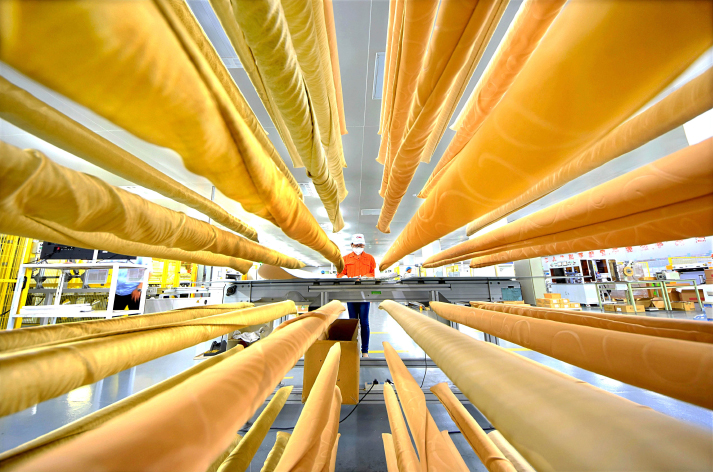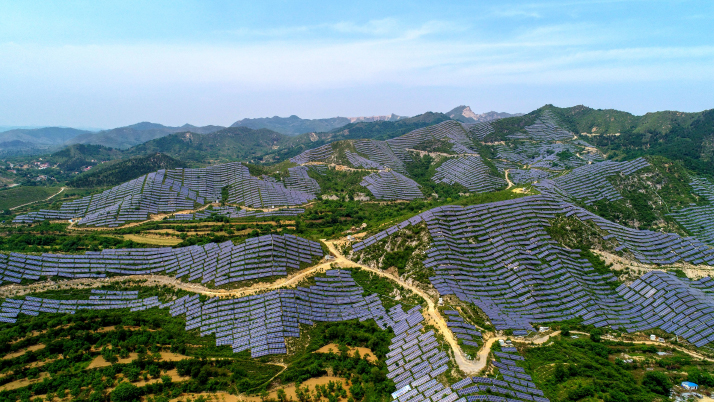| Business |
| Weaning Off | |
| China moves to optimize PV power development | |
|
|
 Workers conduct product testing at a photovoltaic company at the Yuezhuang Industrial Park in Wuyuan County, east China's Shandong Province (XINHUA)
The Chinese Government has released new rules on investment and subsidies for photovoltaic (PV) installations to set the industry on a more rational development path and encourage advanced technologies in the sector. Jointly issued by the National Development and Reform Commission, the Ministry of Finance (MOF) and the National Energy Administration (NEA) on June 1, the new rules state that no construction plans will be advanced for common PV projects this year. Furthermore, for new distributed PV projects, there will be a quota of about 10 gigawatts (GW) this year, while the national feed-in tariff will be cut by 0.05 yuan ($0.008) for every kilowatt-hour as of the beginning of June, except for national-level poverty alleviation PV projects. The new rules aim to cut the feed-in tariff and reduce corporate reliance on government subsidies. Based on pilot programs, the country will release more policies on encouraging direct transactions between PV power generators and users, so as to reduce transaction fees, improve the quality of PV development and promote orderly and sound development of the PV industry, according to Li Chuangjun, Deputy Director of the Department of New Energy and Renewable Energy of the NEA.  A photovoltaic power generation project in Handan City, north China's Hebei Province (XINHUA)
Hi-tech focus According to the new rules, before new official documents can be issued for the resumption of common PV construction projects, local governments must stop building common PV power plants with government subsidies. Moreover, since figures from the NEA show that from January to April of this year, 8.75 GW of newly installed capacity for distributed PV projects has been completed, there is little room left in the 10-GW quota for more new distributed PV projects within 2018. Explaining the reason for this policy, the NEA said in a press release that in recent years a large number of common PV power plants have been built in China, but in some localities, PV capacity is not in full use or has even been abandoned. Therefore with the suspension for 2018, it aims to regulate excessive capacity and more importantly, leave space for the development of advanced technologies and high-quality PV projects in the future. Supported by government subsidies, China's PV industry ranked first in the world for the past five years in terms of newly installed capacity and for the past three years in terms of aggregate installed capacity, according to NEA figures. However, the shortfall of subsidies is growing. The MOF figures showed that by the end of 2017, the country's shortfall of subsidies to renewable energy totaled 100 billion yuan ($15.6 billion). Peng Peng, Secretary General of the China New Energy Power Investment and Financing Alliance, said the new PV rules were issued because of high financial pressure for subsidies. According to an article written by financial commentator Tan Haojun published in the National Business Daily, some companies in the PV industry are shortsighted in their missions and strategies and merely fix their eyes on government subsidies and immediate interests. "At present, most PV generators are still at a low level in terms of technological content, investment and operational costs. Thus, once government subsidies are suspended, they will find it hard to survive," Tan said. "Government subsidies have been the major stimulus of the rapid growth of PV installed capacity in recent years," said Yin Ming, co-founder of Beijing Vision Energy Consulting Co. Ltd. The rapid growth has helped reduce technology costs in the industry and established China's leading position in the global market, according to Yin. However, in the fast-growing downstream market, there have proven to be both good and bad players, throwing the industry into disorder. The new rules don't suspend all government subsidies, but both cutting feed-in tariffs and limiting new projects will lower industrial expectations for subsidies, Yin said. Yin also noted that the PV industry, now like a teenager still being protected, must be weaned away from subsidies. Industrial reorganization The NEA press release also said construction of PV projects that don't need government subsidies will be encouraged. For such projects, local governments can make construction plans on their own. Industrial insiders think the regulations will set off a new round of industrial reorganization, where those firms with advanced technologies, high development quality and a strong ability to control costs will gain new opportunities, while those with low technological content and vulnerable to risks will face severe difficulties. With the issuance of the new rules, the high-speed expansion of the PV industry is likely to stop. Since the fourth quarter of 2016, China's PV industry has been growing at a breakneck speed for five quarters. In 2017, the newly installed capacity reached 53 GW, a year-on-year increase of 53.6 percent. Wang Shujuan, Deputy General Manager of the Department of Technology Standards of Beijing Vision Energy Consulting Co. Ltd., said despite the strict policies, those firms with high efficiency and sound growth will still have opportunities in both domestic and international markets. "In the second half of the year, these firms may face some difficulties, but it won't be too bad for them," she said. In the global market, 70-90 percent of silicon wafers, solar cells and PV modules, as well as over 50 percent of solar inverters are produced by China. "Although the domestic market may be not as good as expected, the international market will still be pretty good," said Wang. Copyedited by Rebeca Toledo Comments to wangjun@bjreview.com |
|
||||||||||||||||||||||||||||
|